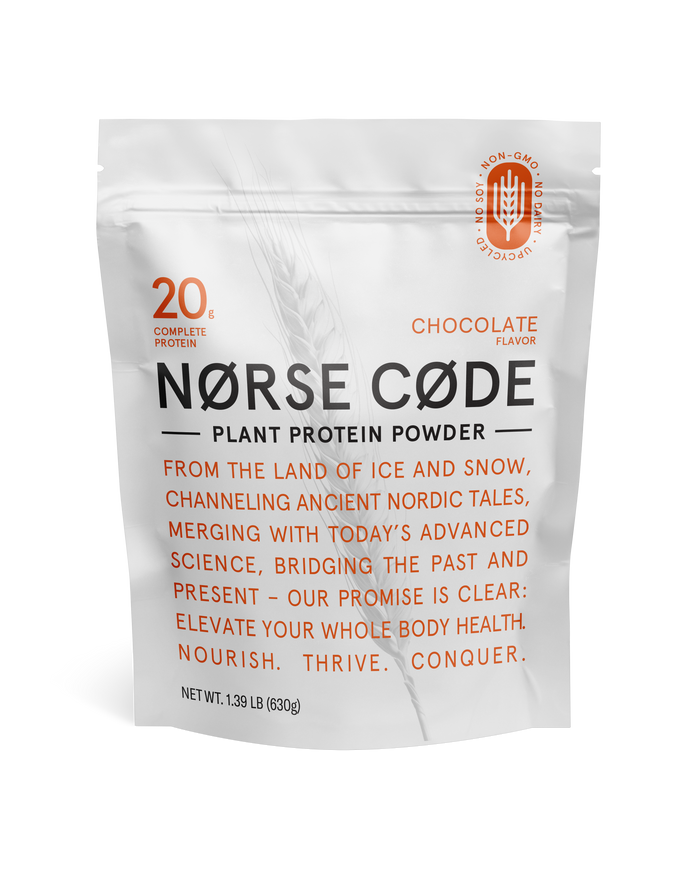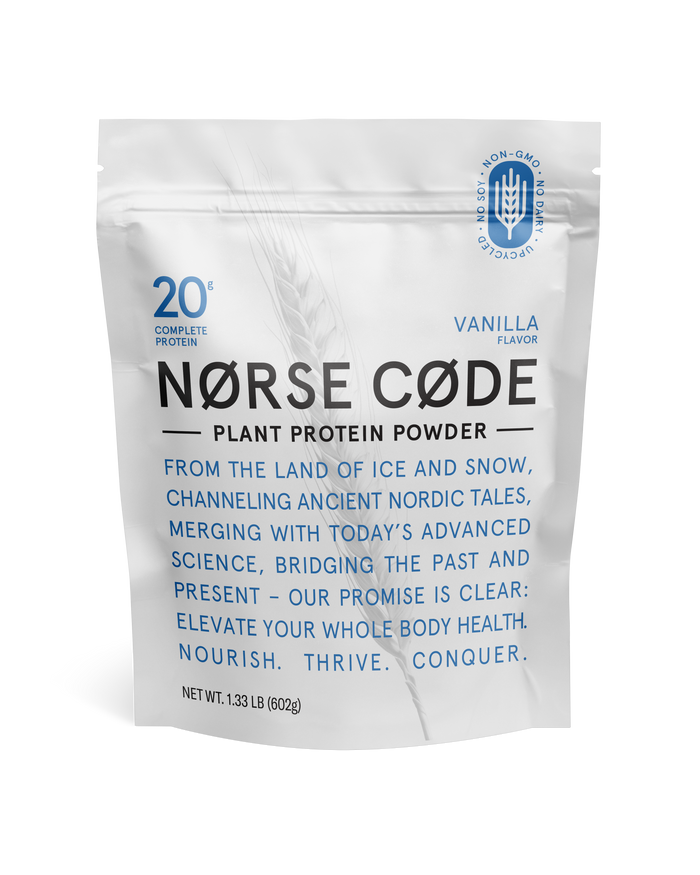
If you’re looking to conquer your fitness goals and optimize your nutrition, you’ve probably considered whey or plant-based protein. But which one is truly better for your body, your planet, and your performance? At NØRSE CØDE, we’re big believers in the power of upcycled barley and pea protein—blended with SmoothBlend™ to create a bold, sustainable fuel for modern warriors. In this article, we’ll explore how whey stacks up against our approach to plant-based performance and why the choice goes beyond just grams of protein.
Understanding the Basics
What is Whey Protein?
Whey is a byproduct of cheesemaking, containing all nine essential amino acids. It’s commonly seen as the “gold standard” in fitness circles, praised for its fast absorption and proven track record in muscle building. However, many people experience bloating, gas, or overall discomfort—often due to the lactose and other dairy compounds in whey.
What is Plant-Based Protein?
Plant-based protein can come from sources like peas, rice, hemp, and, in our case, upcycled barley. Modern formulas combine complementary ingredients to deliver a complete amino acid profile—without dairy or soy. This option often helps minimize stomach issues and reduce environmental impact.
If you’re curious about the overall benefits of going green, check out our Ultimate Guide to Plant-Based Protein for a comprehensive look at how we harness Nordic resilience and modern science to power your day.
Digestion and Gut Health
Whey’s Digestive Hurdles
- Lactose Intolerance: Many individuals can’t process lactose fully, leading to bloating, gas, or diarrhea.
- Potential Allergies: Some people experience allergic reactions to dairy proteins like whey or casein.
- Heavier Feel: Whey can sit in the stomach, especially if it’s thickened or sweetened.
Plant-Based Perks
- No Dairy, Less Bloat: Skipping lactose altogether typically results in a smoother digestive experience.
- Lower Allergen Risk: Pea and upcycled barley proteins are less likely to cause an allergic reaction than dairy—though always check labels if you have specific dietary concerns.
- Prebiotic Boost: While our barley is refined to 85% protein, we add acacia for a gentle prebiotic effect, helping nourish beneficial gut bacteria.
If you want a deeper dive into digestive benefits, head over to Why Vegan Protein Powders Are Easier to Digest.
Nutritional Profiles: Amino Acids and Beyond
Whey Protein
- Fast Absorption: Whey typically digests quickly, flooding muscles with amino acids—beneficial if you’re timing protein intake around workouts.
- High Leucine Content: Leucine is pivotal for muscle protein synthesis, making whey appealing to those focused on muscle gain.
- Some Micronutrients: While it’s mostly protein, some whey formulas add vitamins or minerals. Check labels for specifics.
Plant-Based Protein
- Complete Amino Acid Profile: By combining pea (rich in BCAAs) and upcycled barley (providing complementary amino acids), you get all the essentials.
- Bonus Nutrients: Unlike whey, plant-based sources can offer additional micronutrients and antioxidant compounds—particularly if blends include whole-food elements.
- Fiber or Prebiotic Support: NØRSE CØDE’s formula uses acacia to compensate for removed barley fiber, ensuring a clean, gut-friendly mix.
Looking to learn more about how barley and pea work together? Read The Health Benefits of Upcycled Barley and Pea Protein (And Why They’re Better Together).
Sustainability: The Planetary Impact
Whey Production
- Resource-Intensive: Dairy farming demands significant water, land, and feed for cows.
- Greenhouse Gases: Livestock operations are a key source of methane emissions, adding to climate concerns.
- Waste Concerns: The cheesemaking process produces large volumes of liquid whey. While used in protein powders, the entire cycle still involves substantial resource usage.
Plant-Based (Upcycled Barley + Pea)
- Upcycling for the Win: At NØRSE CØDE, we source Brewer’s Spent Grain (BSG) that would otherwise be thrown out. This second life for barley drastically reduces food waste.
- Lower Carbon Footprint: Plant-based proteins generally require fewer resources (water, land) than animal-based agriculture.
- Environmental Stewardship: Each bag of NØRSE CØDE helps cut down on greenhouse gas emissions by reclaiming barley from the brewing process.
For more on how upcycled barley supports our eco-friendly mission, check out The Ultimate Guide to Plant-Based Protein, where we explore its water-saving potential and minimal land use.
Performance and Muscle Recovery
Whey and Quick Gains
Whey’s rapid absorption can be beneficial right after a workout—your muscles receive amino acids quickly, which can promote muscle protein synthesis. However, if you struggle with gut issues, your recovery might still suffer due to discomfort or inflammation.
Plant-Based Stamina
Plant-based proteins, especially a barley + pea combo, can match whey’s muscle-building potential while offering a steady release of energy. No sudden GI distress, no heavy feeling. Add in fewer inflammation triggers, and you might find your body bounces back faster, letting you conquer your next session.
Wondering if plant-based really supports muscle growth as well as whey? Take a look at How Plant-Based Protein Helps with Muscle Recovery for the full story.
Finding Your Fit: Key Considerations
-
Digestive Comfort
- If dairy leaves you bloated or gassy, plant-based might be your best bet.
-
Allergen Check
- Whey, soy, and gluten are common culprits. Make sure you pick what’s safe for you.
-
Sustainability Goals
- Whey involves animal farming; upcycled barley uses existing resources. Consider your carbon footprint.
-
Taste & Texture
- Modern plant-based formulas (like NØRSE CØDE with SmoothBlend™) deliver a smooth, enjoyable sip—without the chalky aftertaste many older blends had.
So, which protein wins—whey or plant-based? The truth is, it depends on your goals, sensitivities, and values. Whey can be effective for muscle growth but may bring along digestive hassles and a heavier environmental footprint. Plant-based alternatives, especially with upcycled barley, offer a cleaner, eco-friendly route to build strength and fuel your toughest days—often without the bloat.
Ready to unleash your performance with a more sustainable choice?
- Explore Our NØRSE CØDE Product Page to discover how upcycled barley, pea protein, and acacia join forces for a bold, smooth protein blend.
-
Check Out These Reads:
Because true strength comes not just from how hard you train, but from what you choose to fuel your body—and how you care for the world around you.
NØRSE CØDE Chocolate Plant Protein Powder
- Regular
- $44.50
- Sale
- $44.50
- Regular
-
- Unit Price
- per
NØRSE CØDE Vanilla Plant Protein Powder
- Regular
- $44.50
- Sale
- $44.50
- Regular
-
- Unit Price
- per
NØRSE CØDE Stainless Shaker
- Regular
- $35.00
- Sale
- $35.00
- Regular
-
- Unit Price
- per




